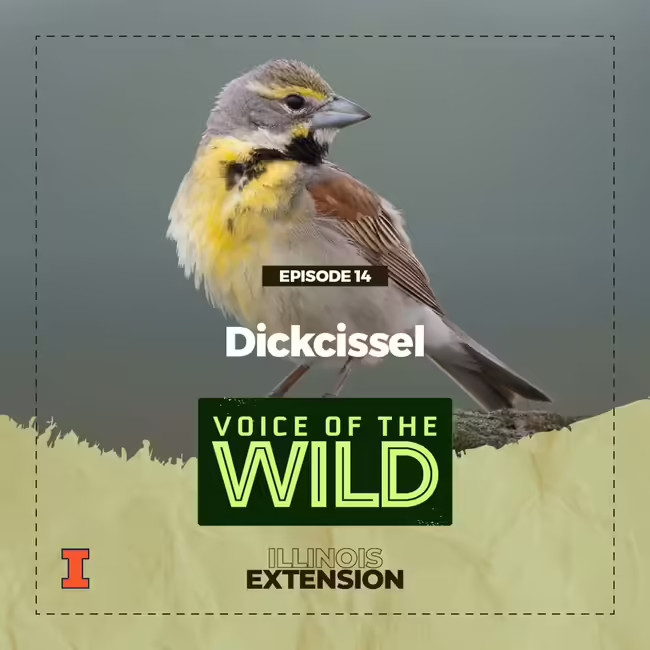
Episode Number
14
Episode Show Notes / Description
Dickcissel (Spiza americana).
In a good tallgrass prairie the Dickcissel’s call can seem to come from every direction. It may have a passing resemblance to a Meadowlark, but on closer inspection you’ll find the Dickcissel is much smaller and has stubby finchlike beak. If you are still unsure, simply wait for the bird to sing it’s own name; dick-dick cissel-cissel.
Do you want to learn more bird songs, frog calls, and insect noises? Join Voice of the Wild every Friday to explore a new wild voice. From time to time, we’ll also do a deep dive into wildlife science, news, and natural history. Voice of the Wild is brought to you by the University of Illinois Extension Natural Resources, Environment, and Energy program.
Available on most podcast platforms, including Apple Podcasts, Spotify, and YouTube.
Subscription links Here
Subscribe to the Newsletter
Listen online on our Homepage
The following Cornell Lab | Macaulay Library recordings were used in this episode:
Dickcissel song by Geoffrey A. Keller (ML509877)
Dickcissel flight call by Paul Coopmans (ML509879)
Dickcissel call by Wil Hershberger (ML509878)
Sources and more:
- https://www.allaboutbirds.org/guide/Dickcissel/overview
- https://www.audubon.org/field-guide/bird/dickcissel
- Sibley, David. Sibley Birds East: Field Guide to Birds of Eastern North America. Second edition. New York: Alfred A. Knopf, 2016. Print.
- Peterson, Roger Tory, and Virginia Marie Peterson. A Field Guide to the Birds: A Completely New Guide to All the Birds of Eastern and Central North America. Fourth edition, completely revised and enlarged. Boston: Houghton Mifflin Company, 1980. Print.
- Dobson, Colin et al. Field Guide to Hotspots and Birds in Illinois. Champaign-Urbana: Scissortail LLC, 2023. Print.
- Godfrey, Michael A, John Farrand, and Roger Tory Peterson. Videoguide to the Birds of North America. New York, N.Y: MasterVision, 1985. Film.
Transcript
This is Illinois Extension’s Voice of the Wild. A new wild voice in just a moment, so find someplace quiet, take a deep breath, and enjoy.
While it is fairly common across the countryside, in a good tallgrass prairie this bird’s call can seem to come from every direction. With its yellow chest overlaid by a black triangle and its tendency to sing from fence posts, you’d be forgiven for mistaking it for meadowlark. With close inspection, you’ll find this member of the cardinal family is in fact quite visually different from the meadowlark; much smaller and with a stubby finchlike beak. Any lingering confusion about the birds identify is typically short lived; that’s because it sings its name; Dick dick cissel cissel.
This is the Dickcissel, Spiza americana from the family Cardinalidae. Besides singing its name, the dickcissel has a unique call it makes in flight, a kind brisk buzz. Here’s the Dickcissel again, first singing its name, then calling, then giving that unique buzzing flight call.
Thank you to the Macaulay library at the Cornell lab for our bird sounds. And thank you for tuning in to learn a new bird call with Illinois Extension.
While it is fairly common across the countryside, in a good tallgrass prairie this bird’s call can seem to come from every direction. With its yellow chest overlaid by a black triangle and its tendency to sing from fence posts, you’d be forgiven for mistaking it for meadowlark. With close inspection, you’ll find this member of the cardinal family is in fact quite visually different from the meadowlark; much smaller and with a stubby finchlike beak. Any lingering confusion about the birds identify is typically short lived; that’s because it sings its name; Dick dick cissel cissel.
This is the Dickcissel, Spiza americana from the family Cardinalidae. Besides singing its name, the dickcissel has a unique call it makes in flight, a kind brisk buzz. Here’s the Dickcissel again, first singing its name, then calling, then giving that unique buzzing flight call.
Thank you to the Macaulay library at the Cornell lab for our bird sounds. And thank you for tuning in to learn a new bird call with Illinois Extension.